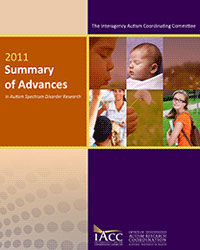Summary of Advances
In Autism Spectrum Disorder Research
2011
Disrupted neural synchronization in toddlers with autism – Dinstein I, Pierce K, Eyler L, Solso S, Malach R, Behrmann M, Courchesne E. Neuron. 2011 Jun 23;70(6):1218-25. [PMID: 21689606]
A study of sleeping toddlers identified patterns of abnormal neural activity that could aid in the early diagnosis of autism and help to understand underlying causes. Using functional magnetic resonance imaging (fMRI), researchers found that 72 percent of children with ASD showed decreased synchronization across brain hemispheres in areas commonly associated with language and communication. This decreased synchronization was rarely seen in typically developing children, or those with delayed language development who did not have autism. Strong synchronization between the right and left hemisphere of the brain is critical for proper functioning, and there is evidence of disrupted synchronization in neurological disorders such as schizophrenia and Alzheimer's disease. While disrupted synchronization has been documented in adults with autism, researchers had been unable to study the phenomenon in early childhood because toddlers cannot remain still long enough to undergo a brain scan when awake. Researchers were able to overcome this challenge by performing scans on sleeping children; neurons remain synchronized between regions of the brain with similar function even while resting. The brain scans revealed that weak neural synchronicity is evident in the early stages of autism and that the strength of synchronization is linked to the degree of the child's symptoms – children with the weakest neural synchronization exhibit the most severe impairments. The researchers note that measures of neural synchronization could one day play a role in early autism diagnosis, particularly because the measure can be taken while the child sleeps.
Detecting, Studying, and Treating Autism Early: The One-Year Well-Baby Check-Up Approach – Pierce K, Carter C, Weinfeld M, Desmond J, Hazin R, Bjork R, Gallagher N. J Pediatr. 2011 Sep;159(3):458-465.e1-6. [PMID: 21524759]
A five-minute checklist filled out by parents at the one-year, well-baby check-up has been shown to predict autism or other developmental delays in about 75 percent of cases. This easily implemented tool is the first validated autism screen for infants and could help pediatricians identify autism even earlier than the evaluations at 18 and 24 months of age recommended by the American Academy of Pediatrics. The screening tool, called the Communication and Symbolic Behavior Scales Developmental Profile Infant-Toddler Checklist, developed by Dr. Amy Wetherby and colleagues, was filled out by parents in the waiting room and took pediatricians only two minutes to review, providing a quick way to identify young children at risk for ASD. The study followed 137 pediatricians in San Diego County who used the tool to screen almost 10,500 infants. About 12 percent of infants screened were flagged by the questionnaire as at-risk for ASD and referred for further evaluation at a clinic. The study followed 184 infants who failed the screen until three years of age and found that 17 percent (32 children) ultimately received an autism diagnosis. Of the remaining children, 30 percent were identified as having a learning disability, 5 percent with a developmental disability, and 20 percent as another type of disability. Overall, the screen yielded about a 30 percent false-positive rate, meaning that 1 out of 3 infants flagged as at-risk during the initial screen did not subsequently receive a developmental disorder diagnosis. The findings demonstrate that the checklist is a convenient and effective screen for autism and other disabilities at the one-year, well-baby check-up – improving the chances of early detection and increasing the opportunity for early intervention. Notably, all 137 pediatricians who participated in the study were still using the checklist when the article was published – a significant improvement from the only 22 percent who were screening at one-year check-ups prior to the study.




